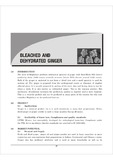Please use this identifier to cite or link to this item:
http://library.ediindia.ac.in:8181/xmlui//handle/123456789/2358Full metadata record
| DC Field | Value | Language |
|---|---|---|
| dc.contributor.author | Entrepreneurship Development Institute of India | |
| dc.date.accessioned | 2015-12-20T16:08:20Z | |
| dc.date.available | 2015-12-20T16:08:20Z | |
| dc.date.issued | 2005-01 | |
| dc.identifier.uri | http://hdl.handle.net/123456789/2358 | |
| dc.description.abstract | The state of Meghalaya produces substantial quantity of ginger with East-Khasi Hill district producing about 5,000 tonnes annually whereas Jaintia Hills district around 2,000 tonnes. Bulk of the ginger is marketed in raw form or dried form and a small quantity is used for making oil. Dry ginger is prepared from the underground shoots or rhizomes of zingiber officinal plant. It is usually prepared by peeling of the outer skin and drying them in sun for about a week. It is also known as unbleached ginger. This is the common practice. But mechanical dehydration increases the production; quality is superior and is more hygienic. This is a versatile product and can be produced in many parts of the country but this note considers Meghalaya as the preferred location. | |
| dc.description.sponsorship | Government of India, Ministry of Food Processing | |
| dc.language.iso | en | en_US |
| dc.publisher | Entrepreneurship Development Institute of India | en_US |
| dc.subject | Project Profiles | en_US |
| dc.title | Bleached And Dehydrated Ginger | en_US |
| dc.type | Other | en_US |
| Appears in Collections: | Ministry of Food Processing Industries | |
Files in This Item:
| File | Description | Size | Format | |
|---|---|---|---|---|
| 3 Bleached and Dehydrated Ginger.pdf | 119.56 kB | Adobe PDF |  View/Open |
Items in DSpace are protected by copyright, with all rights reserved, unless otherwise indicated.
